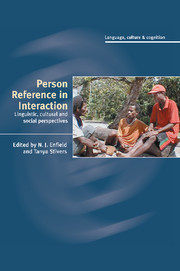Book contents
- Frontmatter
- Contents
- List of contributors
- Preface
- Acknowledgements
- 1 Person reference in interaction
- Part I Person reference as a system
- Part II The person reference system in operation
- 6 Conveying who you are: the presentation of self, strictly speaking
- 7 Person reference in Yucatec Maya conversation
- 8 Principles of person reference in Tzeltal conversation
- 9 The interactional meanings of quasi-pronouns in Korean conversation
- 10 Person reference in Tzotzil gossip: referring dupliciter
- Part III The person reference as a system in trouble
- References
- Index
6 - Conveying who you are: the presentation of self, strictly speaking
Published online by Cambridge University Press: 22 September 2009
- Frontmatter
- Contents
- List of contributors
- Preface
- Acknowledgements
- 1 Person reference in interaction
- Part I Person reference as a system
- Part II The person reference system in operation
- 6 Conveying who you are: the presentation of self, strictly speaking
- 7 Person reference in Yucatec Maya conversation
- 8 Principles of person reference in Tzeltal conversation
- 9 The interactional meanings of quasi-pronouns in Korean conversation
- 10 Person reference in Tzotzil gossip: referring dupliciter
- Part III The person reference as a system in trouble
- References
- Index
Summary
Introduction
Of all the practices for referring to persons in talk-in-interaction, the most common and the most straightforward – at least for English – appears to be self-reference. For English, with very few exceptions (Schegloff 1996a: 443–45), a speaker refers to self with the dedicated term ‘I’ (and its grammatical variants – me, my, mine, etc.). This term is opaque with respect to all the usual key categorical dimensions – age, gender, status and the like, and is also insensitive to the history of prior reference – whether for the first or the nth occasion in some conversation or across multiple conversations, self is referred to as ‘I’.
In this chapter, I exploit one locus of self-reference that is different from the aforementioned routine – saying or otherwise conveying who you are either to a question inquiring about it (‘who are you?’, ‘who is this?’, etc.) or a sequential juncture that makes addressing this undertaking relevant. This locus is the opening section of American telephone calls before the advent of cell-phones and automatic caller-identification.
The forms of self-identification or self-presentation at this interactional juncture are constrained by the same combination of conversational preferences examined elsewhere in the conversation-analytic literature on person-reference (Sacks 1972a, 1972b, 1992; Sacks and Schegloff 1979, this volume; Schegloff 1996a) – recipient design and minimization.
- Type
- Chapter
- Information
- Person Reference in InteractionLinguistic, Cultural and Social Perspectives, pp. 123 - 148Publisher: Cambridge University PressPrint publication year: 2007
- 22
- Cited by



